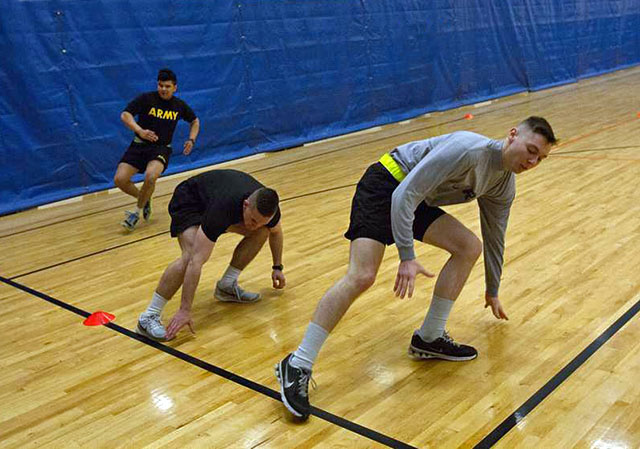The 20 yard agility run is a simple measure of an athlete’s ability to accelerate, decelerate, change direction, and to accelerate again. The participants run to a marker 5 yards either side of them, touching the lines with their foot. The NFL uses a very similar test for the NFL Combine Testing — the 20 yard shuttle in which the starting position is different and the lines are touched with the hands.
test purpose: to measure an athlete’s ability to accelerate, decelerate and change direction.
equipment required: start/stop timing gates or stopwatch, tape measure, non-slip running surface, cone markers.
pre-test: Explain the test procedures to the subject. Perform screening of health risks and obtain informed consent. Prepare forms and record basic information such as age, height, body weight, gender, test conditions. Measure and mark out the course. Ensure that the participants are adequately warmed-up. See more details of pre-test procedures.
test layout: Set up three marker cones in a straight line, exactly five yards apart - cones B, A (center) and C. At each cone place a line across using marking tape. The timer is positioned at the level of the center A cone, facing the athlete.
 agility turn
agility turn procedure: To start, the athlete straddles the center cone A with feet an equal distance apart and parallel to the line of cones. When ready, the athlete runs to cone B (touching the line with either foot), turns and accelerates to cone C (touching the line), and finishes by accelerating through the line at cone A. The stopwatch is started on the first movement of the athlete and stops the watch when the athlete’s torso crosses the center line.
scoring: Record the best time of two trials.
comments: Encourage athletes to accelerate through the finish line to achieve their best possible result.
The Test in Action
- This test was once part of a battery for the USA Women's Soccer Team.
- The NFL uses a very similar test for the NFL Combine Testing, the 20 yard shuttle, in which the starting position is different and the lines are touched with the hands.
Similar Tests
- NFL 20-yard shuttle — run 5-10-5 yards, similar to above but touching the lines with a hand.
- 30 ft shuttle run — run 30ft (9.14m) x 4, moving blocks from one end to the other.
- 60 yards shuttle — run to 5 yards, 10 yards, 15 yards, there and back, for a total of 60 yards
- 300 yards shuttle — run 25 yards and back, repeating this for 12 runs of 25 yards (300 yard total).
Related Pages
- See videos of the 20 yard shuttle test in action.
- See also: other tests of agility
- fitness testing for soccer


 Current Events
Current Events